Strategies for Reclaiming Hay Feeding Areas
By Chris D. Teutsch and Kelly M. Mercier, UK Research and Education Center at Princeton
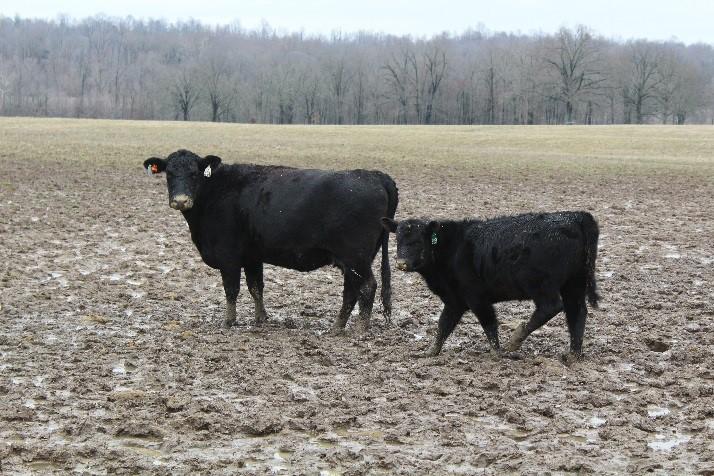
Livestock treading during the winter months can result in almost complete disturbance in and around hay feeding areas. Even well-designed hay feeding pads will have significant damage where animals enter and leave. These highly disturbed areas create perfect growing conditions for summer annual weeds like spiny pigweed and cockle bur. Their growth is stimulated by lack of competition from a healthy and vigorous sod and the high fertility from the concentrated area of dung, urine, and rotting hay. The objective of this publication is to outline strategies for rapidly establishing stands of desirable forage species on these areas.
Regardless of the reclamation strategy that is employed, it is always important to create an environment that will allow seed to germinate quickly and uniformly, and achieve rapid canopy closure. The best defense against summer annual weeds is covering the soil with a desirable forage species. This inhibits weeds from germinating and allows the desirable forage to actively compete with weeds that have already germinated. Creating this environment starts with making sure that soil fertility and pH are adequate, and preparing a fine, but firm, seedbed.
Soil test and adjusting fertility. Damaged areas should be soil tested, and lime and fertilizer applied as needed. In most cases, fertility will be high in hay feeding areas due to high concentrations of dung, urine, and rotting organic material. However, a quick soil test will allow you to confirm this and determine if lime is needed.
Reseeding damaged sods. In most cases, hay feeding areas will need complete renovation. After hay feeding is completed and cattle have been moved onto pastures, reclaiming these areas can begin. In most cases, these areas will need to be harrowed to smooth and level. The goal should be to produce a fine, but firm, seedbed that will enhance soil-to-seed contact, which is essential for rapid germination and uniform emergence of the seeded forage crop. A general rule is that if you walk across a prepared seedbed and sink in past the sole of your shoe, it needs to be re-firmed prior to seeding.
Strategy I: Planting cool-season grasses and legumes
The first strategy is to seed cool-season grasses or a mixture of grasses and legumes in the spring. While this is commonly done, results are usually less than spectacular in most years, due to several reasons. The first is that seedings are normally delayed until late spring or early summer. This does not allow adequate time for the seedlings to develop a large enough root system to sustain them through a hot, and often dry, summer. The second reason is that summer annual weed pressure is very high. Summer annual weeds like foxtail, crabgrass (?), goosegrass, spiny pigweed, cockle bur, and others actively compete with cool-season seedlings for light and water, often causing stand failures.
If a spring planting of cool-season grasses and legumes is attempted, there are several things that can be done to enhance, but by no means guarantee, success. These are listed below.
Plant adapted forage species. Plant forages that are well adapted to Kentucky and the soils and drainage found on your farm. Tall fescue, red clover, and ladino clover are, by far, best adapted and most versatile forage species for pastures in the Commonwealth. Information on the best varieties to use can be found on UK Forages.
Consider leaving legumes out of the mix. While legumes are an important part of grassland ecosystems, herbicide options for controlling weeds in grass-legume mixtures are limited. Leaving legumes out will allow you to apply selective herbicides to control broadleaf summer annual weeds.
Use the high end of the seeding rate. Seeding rates are normally given as a range (Table 1). For spring seedings, make sure to use the high end of this range. Rapid canopy closure is critical to suppressing summer annual weeds.
Plant as early as possible. Spring seeded cool-season forages should be planted starting in early to mid-March. Early plantings will have more time to emerge and form a canopy that can shade summer annual weeds. They will also have additional time to develop a root system that can sustain the developing seeding during the summer months.
Plant in two directions. If drilling, cut seeding rates in half and plant in two directions. This will aid in obtaining quicker canopy closure and hopefully prevent and shade summer annual weeds.
Check seeding depth. Small seeded cool-season forages should not be planted deeper than ½ inch. Make sure to check and recheck your seeding depth. Seeding deeper than ½ inch will delay emergence, result in uneven stands and, in many cases, cause complete stand failure.
Table 1. Seeding rates for a mixture of tall fescue, orchardgrass, red clover, and white clover†. |
|
| Species | Seeding Rate (lb/A) |
| Tall fescue | 10-15 |
| Orchardgrass | 4-6 |
| Red clover | 6-8 |
| White clover | 1-2 |
|
†Do NOT include red and white clover if herbicides will be used to control broadleaf weeds. |
Control broadleaf weeds in cool-season grasses. Once seedlings have four collared leaves, some herbicides can be applied. Always consult and follow label directions. For more information on using herbicides on new seedings, contact your local extension agent.
Clip or flash graze new stands. Summer annual weeds compete very aggressively for light, water, and nutrients with cool-season grass seedlings. If this competition is not controlled, it will likely result in stand failure. The most effective control of this competition is to flash graze these paddocks before weeds get too far along. Flash grazing is accomplished by placing a large number of animals in small areas for a short period of time. This reduces selective grazing and increases grazing uniformity.
Strategy II: Planting warm-season annual grasses
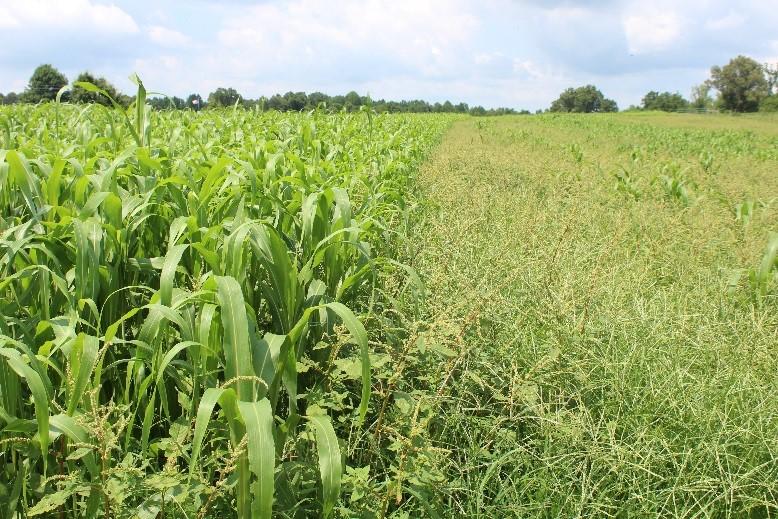
The second strategy involves planting a summer annual grass in late spring or early summer and has much higher probability of success. Summer annual grasses, especially sorghum-sudangrass or sudangrass, have very rapid emergence and canopy closure. This will prevent summer annual weeds from germinating and provide forage for grazing or harvesting during the summer months (Figure 2). Perennial cool-season grasses can then be reseeded under more ideal conditions in late summer or early fall.
If summer annual grasses are used, there are several things that can be done to enhance success. These are listed below.
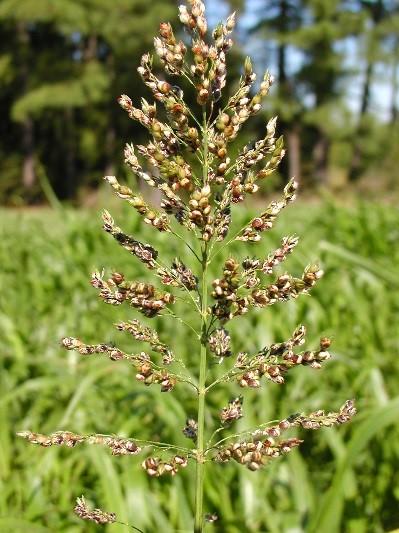
Plant adapted summer annual species. Always plant forages that are well adapted to Kentucky and the soils and conditions on your farm. Summer annuals that can be used to reclaim hay feeding areas include sudangrass, sorghum-sudangrass, pearl millet, and crabgrass. These species are described below, and more information on their establishment and management can be found in the corresponding links.
- Sudangrass is a rapidly growing annual grass of the sorghum family. It is medium yielding and well suited for grazing (Figure 3). Sudangrass regrows quickly after harvest and can be grazed several times during summer and early fall. This grass has finer stems than most other summer annuals, making it well-suited for hay production. For more information, see AGR-234: Sudangrass and Sorghum-sudangrass Hybrids.
- Sorghum-sudangrass hybrids are developed by crossing sorghum with true sudangrass. The result is a tall growing annual grass that resembles sudangrass, but has coarser stems, a taller growth habit, and higher yields. Like sudangrass, hybrids will regrow after grazing if growth is not limited by environmental factors. The coarse stems are difficult to cure as dry hay; therefore, these grasses are best utilized for grazing, chopped silage, and baleage. For more information, see AGR-234: Sudangrass and Sorghum-sudangrass Hybrids.
- Pearl millet is not related to foxtail millet and is higher yielding. It will regrow after harvest, does not have prussic acid potential, and is not a host of the sugar cane aphid (Figure 4). Dwarf varieties are available, which are leafier and better suited for grazing. Pearl millet is better adapted to more acid soils and soils with a lower water-holding capacity than sorghum, sudangrass or sorghum-sudangrass hybrids. For more information, see AGR-231: Pearl Millet.
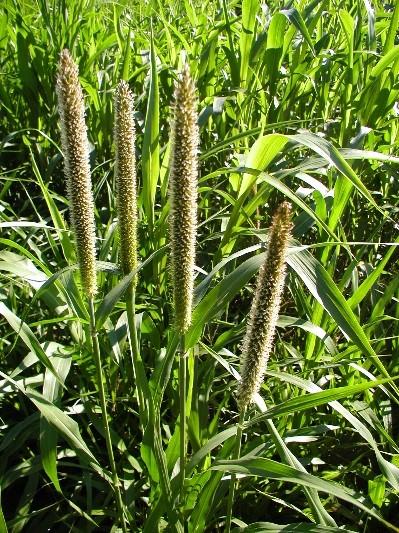
Figure 4. Pearl millet is not quite as vigorous as the sorghum-sudangrasses. - Crabgrass is sometimes considered a weed, but possesses significant potential for supplying high quality summer forage (Figure 5). Crabgrass does not have prussic acid potential and is a poor host for the sugarcane aphid. Crabgrass is the general term for many Digitaria species. Commercial seed usually contains Digitaria sanguinalis (large or hairy crabgrass) or D. ciliaris (southern crabgrass). A primary advantage of crabgrass is that it is well adapted to Kentucky and occurs naturally in most summer pastures, especially those that have been overgrazed. It is also highly palatable, a prolific reseeder, and is best utilized by grazing. Planting an improved variety of crabgrass is recommended because the production of naturally occurring ecotypes varies greatly. For more information, see AGR-232: Crabgrass. Use the high end of the seeding rate. Seeding rates are normally given as a range (Table 2). Make sure to use the high end of this range. Even with summer annuals, rapid canopy closure is critical for reducing summer annual weeds.
Plant after soil warms. For summer annual grasses to germinate and rapidly emerge, soil temperatures at planting should be at least 60 degrees F. As a general rule, this is about two weeks after the “ideal” corn planting date. This should allow plenty of time to let the area dry out and to get it smoothed up prior to planting. If there is a delay in planting the summer annuals after final tillage, it may be a good idea to do one more pass of light tillage to disturb any weed seedlings that may have germinated.
Table 2. Seeding rates for commonly planted summer annual grasses in Kentucky†. |
|
| Species | Seeding Rate (lb/A) |
| Sorghum-sudangrass | 30-40 |
| Sudangrass | 15-20 |
| Pearl millet | 15-20 |
| Crabgrass | 4-6 |
|
†A small amount of crabgrass, 2-3 lb/A, can be seeded with the taller growing summer annual species to fill in thin spots in the stand. |
Control broadleaf weeds. Once warm-season annual grasses are established, some herbicides can be applied to control summer annual broadleaf weeds. If the plan is to reseed cool-season perennials in the fall, make sure to check the label for reseeding restrictions prior to application. Always consult and follow label directions. For more information on using herbicides on summer annual grasses, contact your local extension agent.
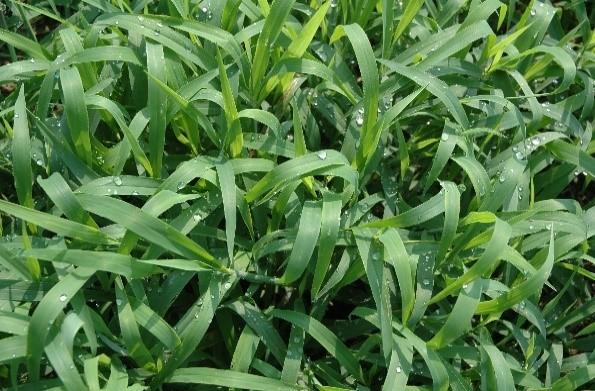
Grazing summer annual grasses. Allow taller growing summer annuals like sorghum-sudangrass and pearl millet to reach a height of 18-24 inches before grazing and stop grazing at 8-10 inches. Regrowth can be stimulated by applying 40-60 lb N/A after each grazing but the last. Crabgrass can be grazed once it reaches a height of 6 to 8 inches. Cattle should be pulled off once it has been grazed to a height of 3 to 4 inches.
Haying summer annual grasses. Allow taller growing summer annuals to reach a height of 30 to 40 inches before mowing. This will optimize yield and forage quality. If regrowth is desired, do not mow closer than 6 inches. Apply 40 to 60 lb N/A after each cutting but the last. Crabgrass should be cut for hay at the late boot-stage. Care should be taken to not mow crabgrass closer than 3 to 4 inches.
Reseeding cool-season grasses in the fall. Pastures should be sprayed with a non-selective herbicide in late summer to control any remaining summer annual grass and any weeds that have germinated. Cool-season grasses can be no-tilled into the killed pasture area. More information on forage establishment can be found in AGR- 64: Establishing Forage Crops.
For more information on renovating pastures and no-till seeding techniques, visit UK Forage Extension or contact your local extension office.
Reclaiming Hay Feeding Areas at a Glance
- Hay feeding during the winter months can result in almost complete disturbance of pasture sods.
- Disturbed areas provide ideal conditions for the growth of summer annual weeds.
- Reestablishing desirable and productive forage species can suppress weed growth and provide high quality grazing.
- Correct soil fertility and pH as needed and prepare a fine, but firm, seedbed.
- Strategy 1: Plant adapted cool-season perennial grasses in early to mid-March
- Plant NO DEEPER than ½” in two directions using the high end of seeding rates.
- Delay planting legumes until following winter to allow use of broadleaf herbicides.
- Clip or flash graze to reduce weed competition.
- Strategy 2: Plant adapted warm-season annual grasses in late spring
- Allow soil temperature to reach 60°F before planting.
- Use high end of seeding rates and control broadleaf weeds.
- Graze crabgrass at 6-8” and all other tall-growing summer annuals at 18-24”.
- Apply 60 lb N/A at seeding and 40-60 lb N/A after each harvest/grazing, except for the last.
- Kill summer annual pasture and any weeds with non-selective herbicide and no-till perennial cool-season forages in late summer-early fall.
Categories:
Establishment/Renovation


